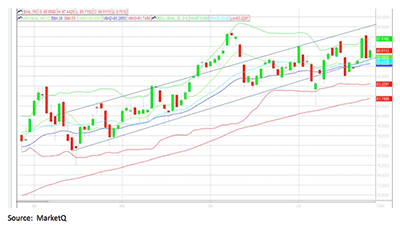Trains and Boats and Planes?
July 28, 2014
“Trains and boats and planes took you away, but every time I see them I pray. And if my prayers can cross the sea, the trains and boats and planes will bring you back, back home to me.”
... Dionne Warwick (1966)
Those of you who know me know that I have had a love affair with boats ever since I was a kid. In my youth it was speedboats on various lakes in Michigan. In my teens, and into my forties, it was sailboats combined with an occasional trawler. In later life, however, it has been strictly powerboats. Currently, we are on a smaller boat, namely a 33’ Wellcraft. Speaking of boats, the newer generation is having an “affair” with Malibu Boats (MBUU/$19.84/Strong Buy), for a multiplicity of reasons, but that’s a discussion for another time. I have also always loved trains ever since my parents took me from Michigan to my grandparent’s home in Kansas during the 1950s. More recently, I have embraced trains for different reasons. Kansas City Southern (KSU/$114.25/Outperform) is one of those names. Our fundamental analyst has excellent reports on this company, but a few years ago it occurred to me that Mexico had a decent chance of becoming the “New China” for the United States. Clearly the election of smarter policymakers in Mexico is leading to smarter policies typified by the change in Mexico’s energy policies. Well, KSU is an interesting way to get at the “New China” theme since it has rail beds that allow freight to be shipped from Mexico into the heartland of the U.S.
Another name featured more than a year ago in these reports has been Strong Buy-rated Genesse & Wyoming (GWR/$102.28). Hereto, our fundamental analyst has numerous reports on the case for GWR, but my interest was sparked by a gentleman I met on a cross country plane ride in the summer of 2013. The man in question owned a “short line” railroad. A short-line railroad is basically defined as a railroad that operates over a relatively short distance. In my airplane companion’s case it was a ~370 mile railroad in the Dakotas, but I digress. The “thin reed” of information he gave me was about insurance for his company. As it turns out, after the train tragedy in Lac-Megantic Quebec, where a derailment caused an explosion that killed 47 people, insurance coverage requirements were increased dramatically. According to my seatmate, coverage for his company needed to be raised by some 400% with a concurrent increase in premiums. Armed with that information, some back of the envelope research showed there are about 530 short-line railroads in the U.S., most of which are owned by “mom and pops,” and marginally profitable. The inference is that with such a dramatic increase in insurance costs many of said short-lines will have to be sold. Enter Genesse & Wyoming, which owns more than 100 short-line railroads, and which will likely be the consolidator for many of the “mom and pops.” As the safest, and most efficient, operator Genesse & Wyoming is the likely consolidator of choice. Moreover, given recent events, government regulators are having much more to say about who can acquire short-line railroads. Hereto, Genesse & Wyoming is the logical choice. This brings me to planes.
Airplanes have been in the headlines recently. Unfortunately, it has been for tragic reasons. Indeed, last Friday’s USA Today Weekend edition’s headline read, “1 week, 462 lost in crashes,” with the byline, “Four months after Malaysia Airlines Flight 370 disappeared, three other air disasters have occurred. Commercial jet crashes are rare, but it’s not unprecedented that they occur over a short time period.” Such headlines have caused some weakness in the airline complex, as can be seen in the chart on page 3 of the NYSE ARCA Airline Index (XAL/$86.61). From a technical analysis perspective, if the XAL doesn’t hold the bottom-end of the parallel channel seen in the chart, and then breaks below its 50-day moving average (@84.90), the airline group could be in for a pause/pullback after a pretty spectacular rally over the past year and a half. Speaking to that, our airline analysts, Jim Parker and Savanthi Syth, write:
After a year and a half of strong stock performance and four years after the recovery in earnings, the question on investors' minds is if the earnings and margin expansion story is over for the airline sector. In the last few weeks there have been indications of weakness in the Transatlantic market as a result of oversupply. Moreover, following over four years of mostly healthy unit revenue growth in the face of large capacity additions, the Latin American market is starting to show some signs of softening. This, combined with expected moderation in unit revenue growth in 3Q14 due to very tough comps, caused U.S. airline stocks to sell off sharply (last) Thursday. However, we believe the outlook remains positive and that the 2-4% unit revenue growth outlook in 3Q14 is favorable, especially given benign fuel cost trends. Thus, we reiterate our Outperform ratings on AAL, ALK, ALGT, DAL, SAVE, and UAL.
Our analysts went on to discuss three airline themes: 1) returning cash to shareholders; 2) moderating unit revenue growth on tougher comparisons; and 3) capacity discipline holding. For more detailed information, please see our analysts’ report.
Last week, however, most of the equity markets were not dancing to Dionne Warwick’s “Trains and Boats and Planes” (actually it was written by Burt Bacharach) because the “trains and boats and planes” didn’t bring the markets back to me. Well, that is not entirely true, for the anticipated upside breakout in the Chinese ETFs written about in last week’s Morning Tack occurred driven by the best Chinese manufacturing activity in 18 months (see chart on page 3). Yet, the economic news in our country was mixed, leaving most of the major indices I monitor flat to down for the week, save the NASDAQ complex. As for sectors, the Energy (+0.82%), IT (+0.73%), Healthcare (+0.71%), and Materials (+0.35%) sectors were the only macro sectors better for the week. The Energy sector makes sense to me since analysts have been raising earnings estimates at the fastest rate (+19.1%) of all the sectors. The Materials sector does not make sense because analysts are lowering estimates at the fastest rate for the Materials, Telecom, Consumer Staples, and Financial sectors. As for companies reporting 2Q14 results, of the companies that have reported so far, 64.3% have beaten earnings estimates, while 62.3% have better revenue estimates. Within those reporting companies, names from our research universe that have beaten earnings and revenue estimates, and raised forward earnings guidance, and are positively rated by our fundamental analysts include: Amerisource Bergen (ABC/$76.79/Outperform), Manhattan Associates (MANH/$31.45/Outperform), RF Micro (RFMD/$10.89/Strong Buy), Skyworks (SWKS/$51.44/Strong Buy), SBA Communications (SBAC/$103.22/Strong Buy), and United Health (UNH/$84.68/Strong Buy). If we fail to get the pullback I am looking for, this could be a good list in which to redeploy the cash I suggested raising using stocks that have not performed in the 40%+ rally since June 2012.
The call for this week: At the end of this week we get the GDP report, a Fed decision, and non-farm payrolls. All of those are potentially market moving. To that “market moving” point, it is worth noting since the S&P 500 (SPX/1978.34) moved into the 1950 – 1975 zone, targeted by the April 15, 2014 upside reversal at 1816, the SPX has virtually gone nowhere. Meanwhile, the small/mid-cap complex has suffered a decent decline. That negative “price divergence” comes on top of the negative “breadth divergence” previously discussed in these reports. Whether that leads to a full-blown pullback remains to be seen, but it is a reason for near-term caution. This morning the headlines read, “Gaza Fighting Abates as Diplomatic Tensions Flare,” European Markets Subdued, Russian Shares Tumble on New Sanctions,” “Iran Casts Shadow in Asia,” “Argentina Default Looms as Time Runs Out for Debt Deal,” etc. Still, the pre-opening futures are flat. That may be because our ineffectual policy responses to situations around the world are sending the message to Wall Street that “no policy response” implies there will be no direct impact on the economy, and thus the equity markets, as things get curiouser and curiouser.
















